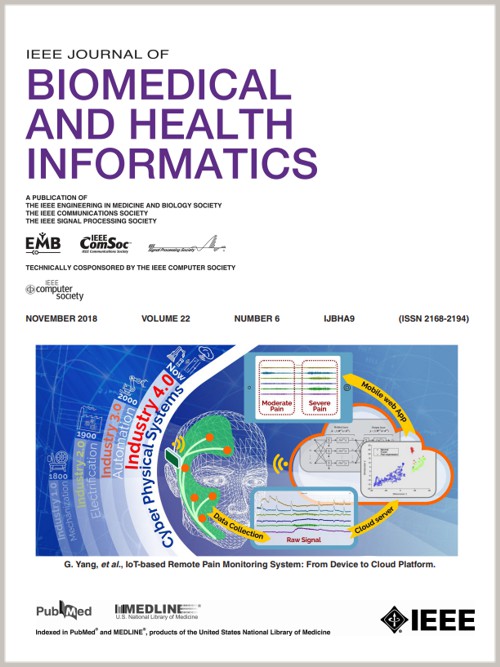TKR-FSOD:利用拓扑知识推理的胎儿解剖结构少拍检测。
IF 6.7
2区 医学
Q1 COMPUTER SCIENCE, INFORMATION SYSTEMS
IEEE Journal of Biomedical and Health Informatics
Pub Date : 2024-10-14
DOI:10.1109/JBHI.2024.3480197
引用次数: 0
摘要
超声(US)图像中的胎儿多解剖结构检测可以清晰地呈现解剖结构之间的关系和影响,提供更全面的胎儿器官结构信息,帮助超声技师做出更准确的诊断,广泛应用于结构评估。最近,深度学习方法在检测超声图像中的各种解剖结构方面表现出了卓越的性能,但在罕见疾病等难以获得样本的类别中,其性能仍有提升的潜力。由于少数几次学习能够解决数据稀缺的问题,因此在医学图像分析领域引起了广泛关注。然而,现有的医学图像分析中的少数几次学习研究主要集中在分类和分割方面,对物体检测的研究一直被忽视。本文提出了一种新型的超声图像胎儿解剖结构少拍检测方法 TKR-FSOD,该方法通过拓扑知识推理模块学习拓扑知识,帮助模型推理和检测解剖结构。此外,我们还提出了判别能力增强特征学习模块,提取丰富的判别特征来增强模型的判别能力。实验结果表明,我们的方法优于最先进的基线方法,在 4CC 下对 split 1 的 5 次拍摄中,我们的方法以 4.8% 的最大余量超过了第二好的方法。代码可在以下网址公开获取:https://github.com/lixi92/TKR-FSOD。本文章由计算机程序翻译,如有差异,请以英文原文为准。
TKR-FSOD: Fetal Anatomical Structure Few-Shot Detection Utilizing Topological Knowledge Reasoning
Fetal multi-anatomical structure detection in ultrasound (US) images can clearly present the relationship and influence between anatomical structures, providing more comprehensive information about fetal organ structures and assisting sonographers in making more accurate diagnoses, widely used in structure evaluation. Recently, deep learning methods have shown superior performance in detecting various anatomical structures in ultrasound images, but still have the potential for performance improvement in categories where it is difficult to obtain samples, such as rare diseases. Few-shot learning has attracted a lot of attention in medical image analysis due to its ability to solve the problem of data scarcity. However, existing few-shot learning research in medical image analysis focuses on classification and segmentation, and the research on object detection has been neglected. In this paper, we propose a novel fetal anatomical structure few-shot detection method in ultrasound images, TKR-FSOD, which learns topological knowledge through a Topological Knowledge Reasoning Module to help the model reason about and detect anatomical structures. Furthermore, we propose a Discriminate Ability Enhanced Feature Learning Module that extracts abundant discriminative features to enhance the model's discriminative ability. Experimental results demonstrate that our method outperforms the state-of-the-art baseline methods, exceeding the second-best method with a maximum margin of 4.8% on 5-shot of split 1 under four-chamber cardiac view.
求助全文
通过发布文献求助,成功后即可免费获取论文全文。
去求助
来源期刊

IEEE Journal of Biomedical and Health Informatics
COMPUTER SCIENCE, INFORMATION SYSTEMS-COMPUTER SCIENCE, INTERDISCIPLINARY APPLICATIONS
CiteScore
13.60
自引率
6.50%
发文量
1151
期刊介绍:
IEEE Journal of Biomedical and Health Informatics publishes original papers presenting recent advances where information and communication technologies intersect with health, healthcare, life sciences, and biomedicine. Topics include acquisition, transmission, storage, retrieval, management, and analysis of biomedical and health information. The journal covers applications of information technologies in healthcare, patient monitoring, preventive care, early disease diagnosis, therapy discovery, and personalized treatment protocols. It explores electronic medical and health records, clinical information systems, decision support systems, medical and biological imaging informatics, wearable systems, body area/sensor networks, and more. Integration-related topics like interoperability, evidence-based medicine, and secure patient data are also addressed.
 求助内容:
求助内容: 应助结果提醒方式:
应助结果提醒方式:


